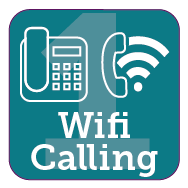With more people at home using the same connection, you can manage your data use and help everyone get the bandwidth they need – for video streaming, virtual meetings or voice calls.
Click or tap to jump to:
1. Use your landline or wifi calls if you can
More people are making calls on their mobile during the day. Because of this high demand, you might get a more reliable connection using your landline. If you do need to use your mobile, use your settings to turn on ‘wifi calling’. Some smartphones and mobile packages allow you to make calls over your broadband network, which often provides the best sound quality and helps reduce demand on the mobile network. You can make voice calls over the internet using apps like Facetime, Skype or WhatsApp.
2. Test the speed on your broadband line
Find out what speed you’re actually getting. You can run a speed test using an Ofcom accredited price comparison site such as Broadband.co.uk and Broadbandcompared.co.uk. If possible, carry out tests over a few days and at different times of day. A few things can affect wifi speeds, so look on your provider’s website for how to improve your signal around the home.
3. Move your router clear of other devices
Keep your router far away from other electrical devices, and those which work wirelessly. Halogen lamps, dimmer switches, stereos and computer speakers, some types of baby monitors, TVs and computer monitors can all affect your wifi if they’re too close to your router. Did you know that microwave ovens can also reduce wifi signals? So don’t use the microwave when you’re making video calls, watching HD videos or doing something important online. Also, place your router on a table or shelf rather than on the floor, and keep it switched on.
4. Lower the demands on your connection
The more devices that use your wifi, the lower the speed you get. Devices like tablets and smartphones often work in the background, so switch off wifi reception on these when you’re not using them. If you’re making video calls or meetings, turning off the video and using audio only will use much less of your internet connection. Or, try starting them at less common times, rather than on the hour or half hour. You could also want to manage your family’s online activity, so different people aren’t carrying out data-heavy tasks (like HD streaming, gaming or video calls) at the same time. It can also help to download video in advance, instead of streaming it.
5. Try wired rather than wireless
For the best broadband speeds, use an Ethernet cable to connect your computer directly to your router, instead of using wifi. This is a computer cable which should give you a faster, more reliable connection. They’re available from around £3.
6. Plug your router directly into your main phone socket
Try not to use a telephone extension lead, as these can cause interference which could lower your speed. If you must use an extension lead, use a new, high-quality cable that is as short as possible. Tangled and coiled cables can also affect speeds. So can interference from your phone line, so try plugging ‘microfilters’ into every phone socket in your home. They are little white boxes and split the phone and broadband signals so they don't affect each other. Different telecoms companies use different setups in the home, so always check their website before unplugging any cables.
7. Get advice from your broadband provider
If your connection still isn’t working as well as it should, get advice from your broadband provider’s website. You can also access it on your mobile phone.
For more information, see our guides on getting the most out of your broadband and mobile services at home.
An easy-read version (PDF, 1.1 MB) of this guide is available.







